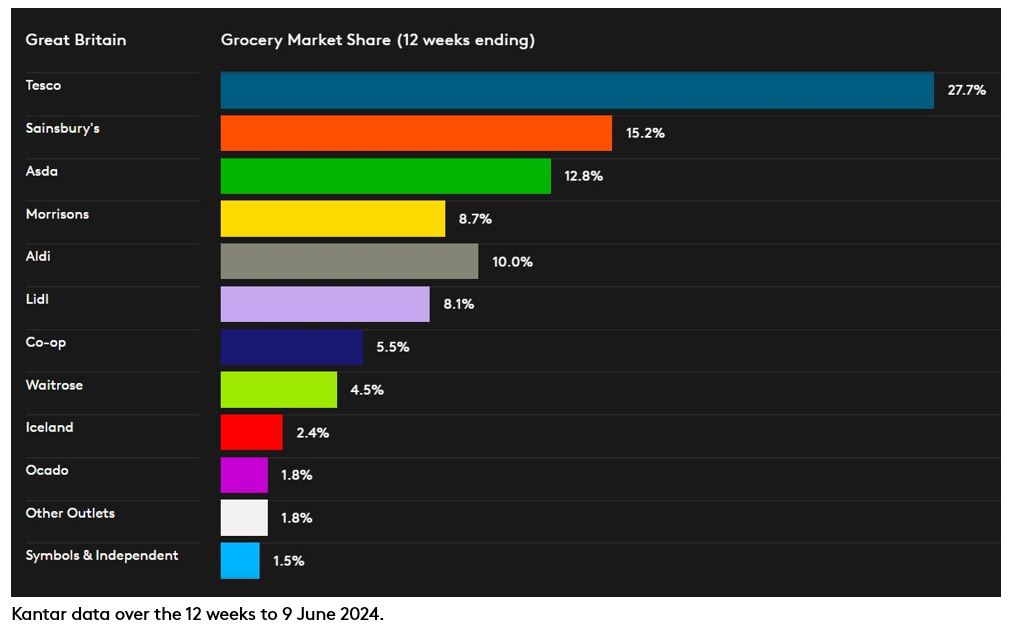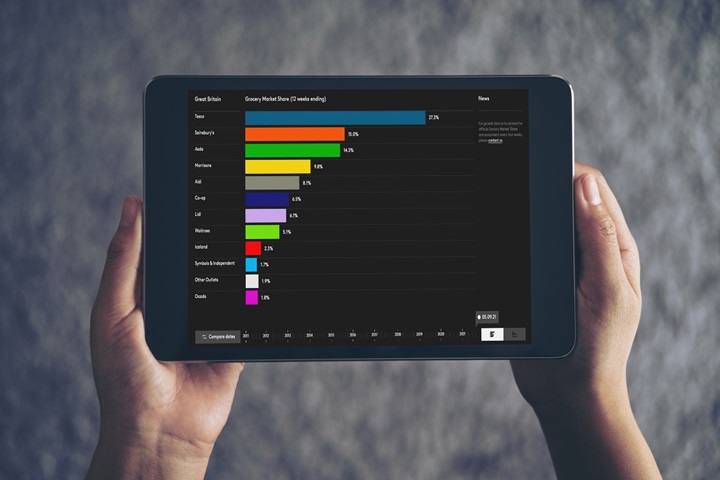Take-home grocery sales rose by just 1.0% over the four weeks to 9 June 2024, marking the slowest increase since June 2022 as poor weather and falling inflation impacted the sector, according to our latest data. Growth in footfall has also stalled, with the average shopper visiting a supermarket 16.3 times this month – down from 16.4 in June last year.
The sixth wettest spring on record hasn’t just dampened our spirits leading into summer, it’s made a mark on the grocery sector too as it seems Britons are being put off from popping to the shops. We’re not yet reaching for those typical summertime products and are making some purchases you wouldn’t expect in June. Consumers bought nearly 25% fewer suncare items this month compared with last year, while prepared salads dipped by 11%. On the other hand, warming fresh soup sales jumped by almost 24%.
Lowest grocery inflation since October 2021
While it might be contributing to slower market growth, a drop in grocery price inflation is leading to improved consumer sentiment. The rate now stands at 2.1%, marking the sixteenth consecutive month that it has fallen. 36% of households described their financial position as comfortable in May 2024, a proportion not surpassed since November 2021.*
The cost-of-living crisis isn’t over – far from it. 22% of households say they’re struggling, meaning that they aren’t able to cover their expenses or are just making ends meet. However, there are positive signs that many of us no longer feel the need to restrict our spending quite so much, with lower inflation helping to ease the pressure on people’s pockets. In May, we recorded the largest jump in the number of comfortable households since January 2023, rising by two percentage points on February 2024’s figure. Costs are falling in nearly one third of the grocery categories we track, including toilet tissues, butter and milk. That’s a big increase from last year, when just 1% of markets were declining.
With the men’s UEFA European Football Championship underway, the supermarkets will be waiting to see if positive performances by England and Scotland can deliver a win at the tills too. The grocers are looking to entice in consumers enjoying this year’s tournament, with the proportion of beer and lager sales on promotion leaping up to over 40% in the latest four weeks. Retailers will be competing with fans heading out of the house to watch the football as well as with each other. Pubs especially could benefit from a boost – whether or not football comes home. Throughout the last tournament held in 2021, sales of food and non-alcoholic drinks in pubs soared by 60% compared with the average month that year.**
Ocado, Lidl, Tesco, Sainsbury's and Iceland win share
Ocado was the fastest growing grocer for the fourth month in a row this period, increasing sales by 10.7% over the 12 weeks to 9 June – ahead of the total online market, which saw sales rise by 4.0%. Nearly a quarter (23%) of British households did their grocery shopping online in the last three months, with over 4% choosing to use Ocado. The online-only retailer now accounts for 1.8% of the market, up 0.1 percentage points from last year.
Lidl increased its hold of the market by 0.4 percentage points to 8.1%, matching its sales growth for the latest 12 weeks. Fellow discounter Aldi, the fourth largest retailer by consumer spend, boosted sales by 0.8% and now has a share of 10.0%.
Tesco achieved its highest market share since February 2022, growing 0.6 percentage points to 27.7% and pushing up sales by 4.6%. Sainsbury’s saw its sales rise by 4.9% to account for 15.2% of the market, up from 14.9% last year.
As Morrisons celebrates its 125th anniversary, the grocer’s sales rose by 1.1%. Its share now stands at 8.7%. Iceland boosted sales by 4.4% and holds 2.4% of the market, up from 2.3% a year ago. This marks the first annual market share increase for the frozen-food specialist since March last year.
Waitrose welcomed 188,000 new shoppers through its doors over the latest 12 weeks, a greater increase than any other grocer. With its sales growing by 3.5%, the retailer has a 4.5% share, while Asda and convenience retailer Co-op captured 12.8% and 5.5% of the grocery market respectively.
*Kantar’s PanelVoice Pressure Groups Survey, May 2024, 10,509 panellists interviewed
**Kantar’s Out of Home Panel – Data for 11 June – 11 July 2021 vs the annual average for 2021



